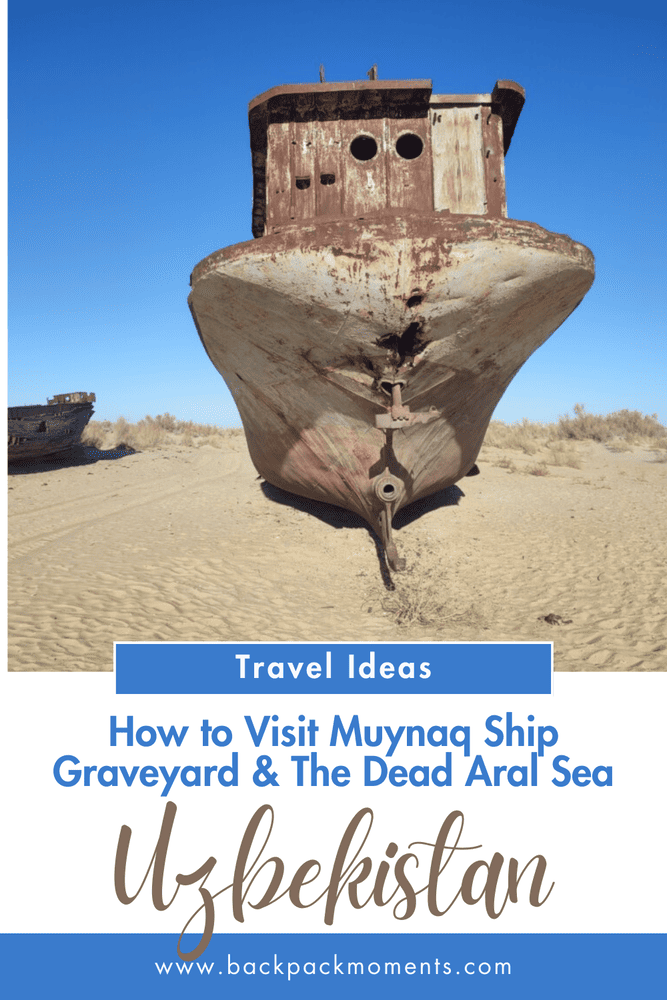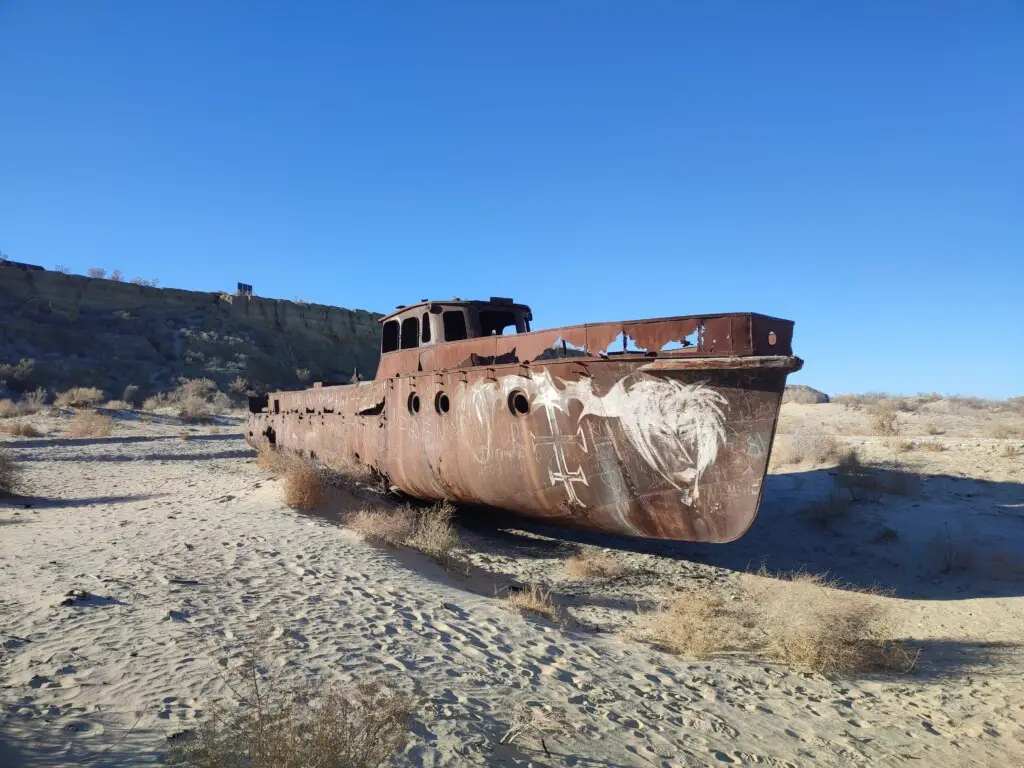How to Visit Muynaq Ship Graveyard & The Dead Aral Sea
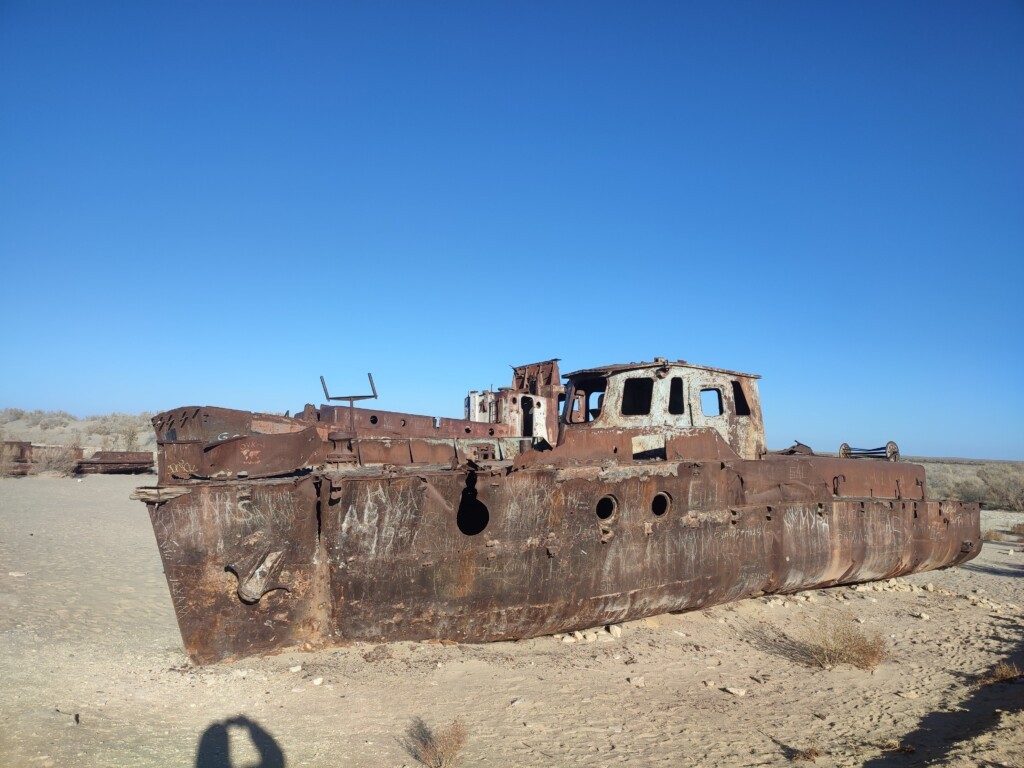
This post may contain affiliate links. If you make a purchase using one of these links, I may receive a small reward at no extra cost to you. See my Disclosure Policy for more information.
The Aral Sea was the fourth-largest lake in the world as recently as the 1960s. Now, its largest remnant – the North Aral Sea – is in position 41, a whopping 21 times smaller!
All the water left in the Aral Sea in 2025 is less than 10% of the water in 1960.
For all intents and purposes: fishing, sailing, wildlife, and biological balance, the Aral Sea is dead. Today, fishing villages that were once thriving and wealthy are dusty forgotten outposts in the middle of a desert.
Such is the case with Muynaq (or Moynaq/Mo‘ynoq) in Uzbekistan, which is now an almost unbelievable 150 km. away from the sea. In 1960 it was a thriving fishing village. Not anymore.
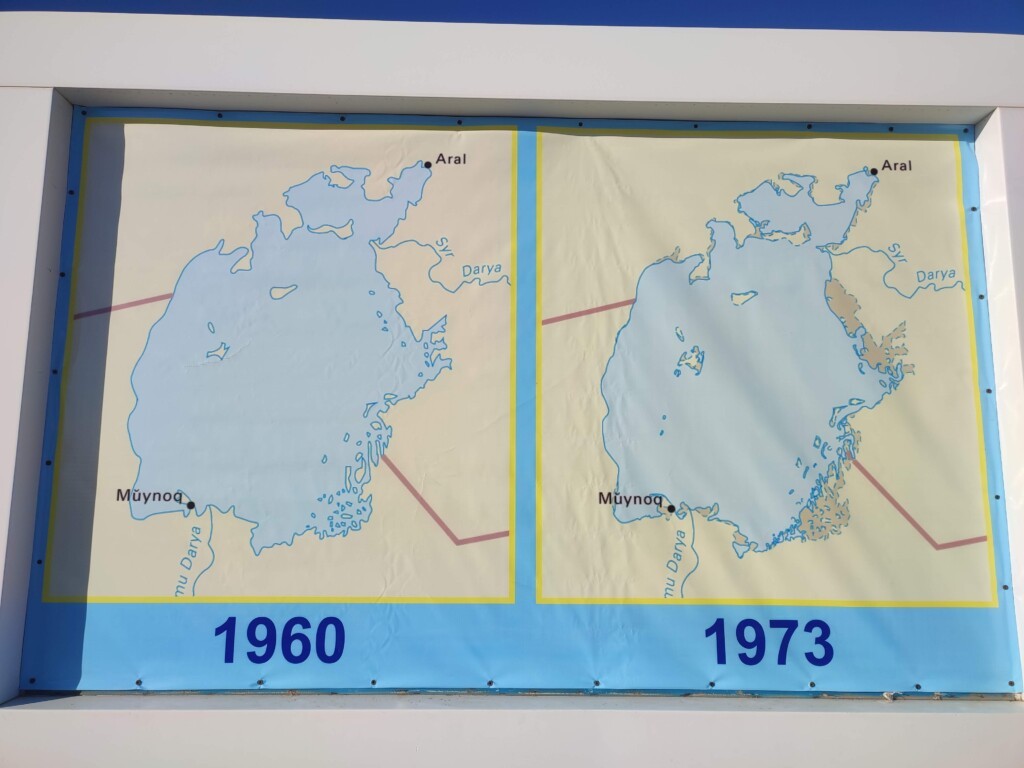

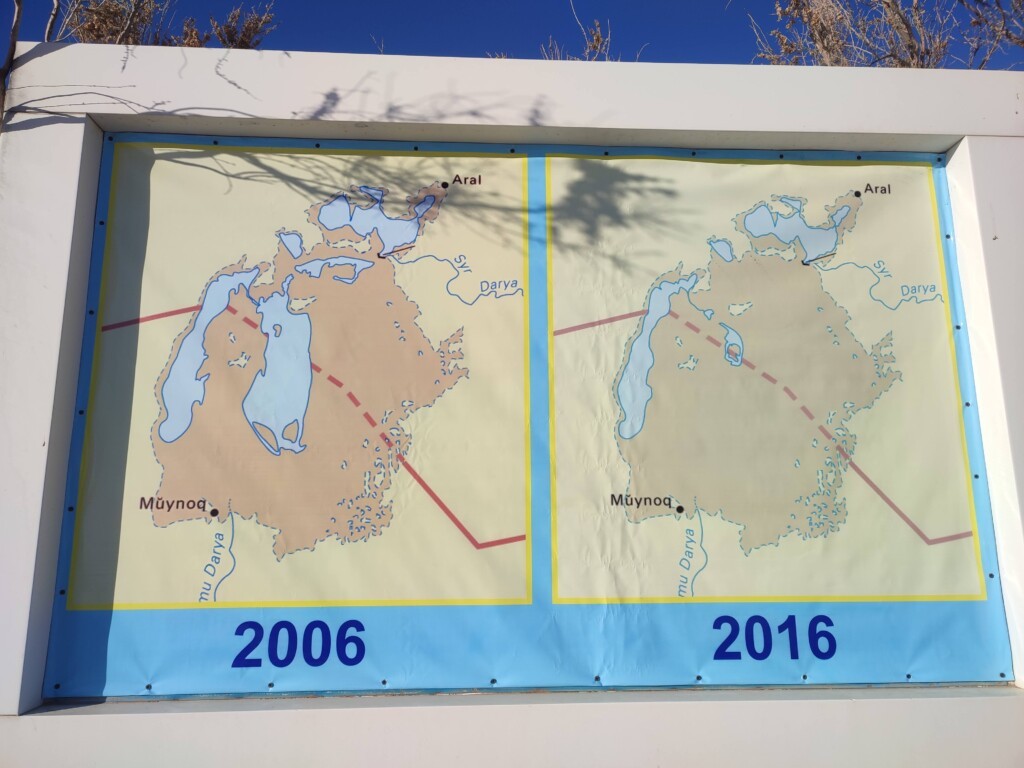
As the sea shrank, the fishermen abandoned their ships on the old coast (what is now called The Ship Graveyard) as a solemn reminder of the dangers of an ecological collapse.
How to get to Muynaq
Muynaq can feel like it’s in the middle of nowhere. It’s pretty far from every other tourism hotspot in Uzbekistan. Few people visit. Packaged holidays don’t include it.
From Tashkent to Nukus
If you’re coming from Tashkent, you must first make your way to Nukus. Two daily flights on Uzbekistan Airways fly from Tashkent to Nukus and cost about 70-80$.
A far cheaper alternative is to travel by train. An overnight train from Tashkent to Nukus costs 175000 UZS / 15.3$ for Platzkartniy and takes 17 hours. You can also take the train to Kungrad, a few hours after Nukus and closer to Muynaq.
It’s the international train from Tashkent to Volgograd and only runs on Saturday and Wednesday (arriving in Nukus the next day).
Book in advance, as beds sell out! That’s the official website.
From Khiva to Nukus
If you’ve been exploring Uzbekistan for some time now, you might be in Khiva and want to get to Nukus.
The best option is a shared taxi. First, you must get to Urgench because that’s where the shared taxis depart from.
To get to Urgench from Khiva it’s best to take the tram. It’s cheap and convenient. If that’s not an option, there will be many shared taxis waiting for passengers where the tram stop is in Khiva (north entrance).
In Urgench, the shared taxis to Nukus gather in front of the Olympic Stadium. It’s about 40 min walk from the center, but any taxi will take you there cheaply.
A shared taxi from Urgench to Nukus should cost no more than 60.000 UZS / 5.3$.
From Nukus to Muynaq
There’s a daily bus from Nukus directly to Muynaq leaving at 8:30 (waiting until 9:00 if not enough people) in the morning. from the Avtovokzal (the bus station). The bus station is around 4 km away from the center, so you might want to take a taxi.
The bus from Nukus to Muynaq costs 20000 UZS / 1.8$ and takes about 3 hours.
I traveled in late November and it was freezing cold both outside and inside, do keep that in mind.
If you miss this bus, there’s an alternative. First, get a shared taxi to Kungrad, then change to another going to Muynaq.
A direct shared taxi between Nukus and Muynaq is rare, but if you’re lucky, it would cost around 30000-40000 UZS / 2.60-3.50$.
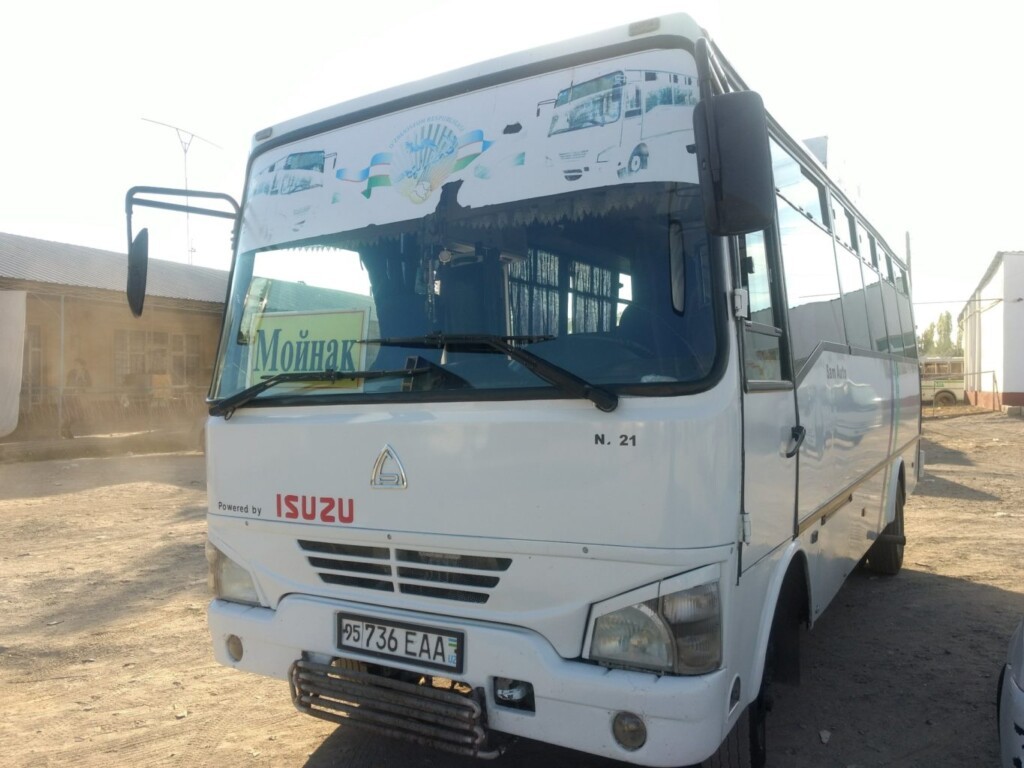
Getting back from Muynaq
Getting back to Nukus from Muynaq is possible on the same day. The same bus that brought you to Muynaq goes back to Nukus at 3:00 PM, giving you around 3 hours to explore the Ship Cemetery in Muynaq. It’s enough, but I strongly advise you to spend the night there to get a feel for this place.
What I did when I was in Muynaq was to go back to Kungrad the following day and take a 21-hour train all the way back to Tashkent.
What to see in Muynaq
Muynaq is a dying town. It’s nowhere near its former glory of the main Uzbek fishing port on the Aral Sea with a major fish canning factory that now sits abandoned and in ruins.
It’s a small town without much to see. Chances are, if you’re coming to Muynaq, it’s because of the Ship Graveyard.
The Ship graveyard
From the bus station, you can get on the only bus in town, marshrutka #1, that goes up and down the main street. Alternatively, you can walk the 4km.
Once you get to the old coastline, you’ll notice a cliff and then an endless expanse of barren desert. A few cows here and there, barely getting by with the measly amount of vegetation there is on the former sea floor. And ships. Rusty, abandoned, hollow, iron ships.
There are around 50 or so ships scattered in what used to be the port. The running theory is that they were just abandoned as the water disappeared, but I have a slight suspicion they might’ve been put together and lined up on purpose. One thing is for certain – the ships are eerie and bizarre.
This is the Aral Sea Ship Graveyard.
You can climb the ships, take pics, and roam around. There’s no entry fee.
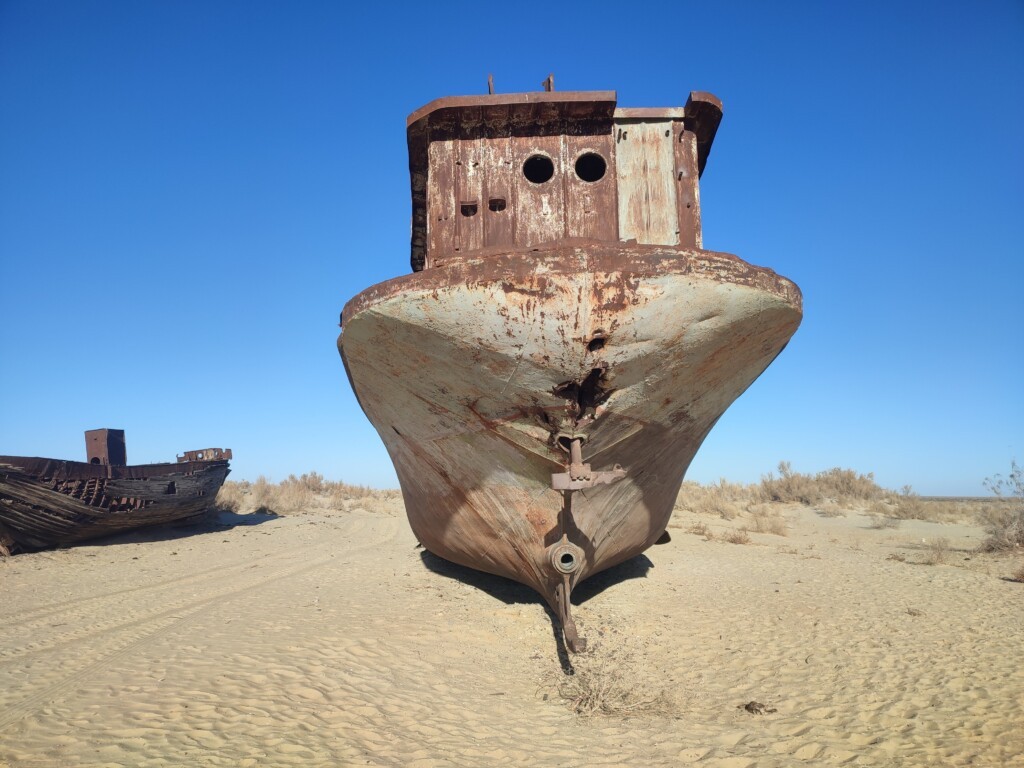

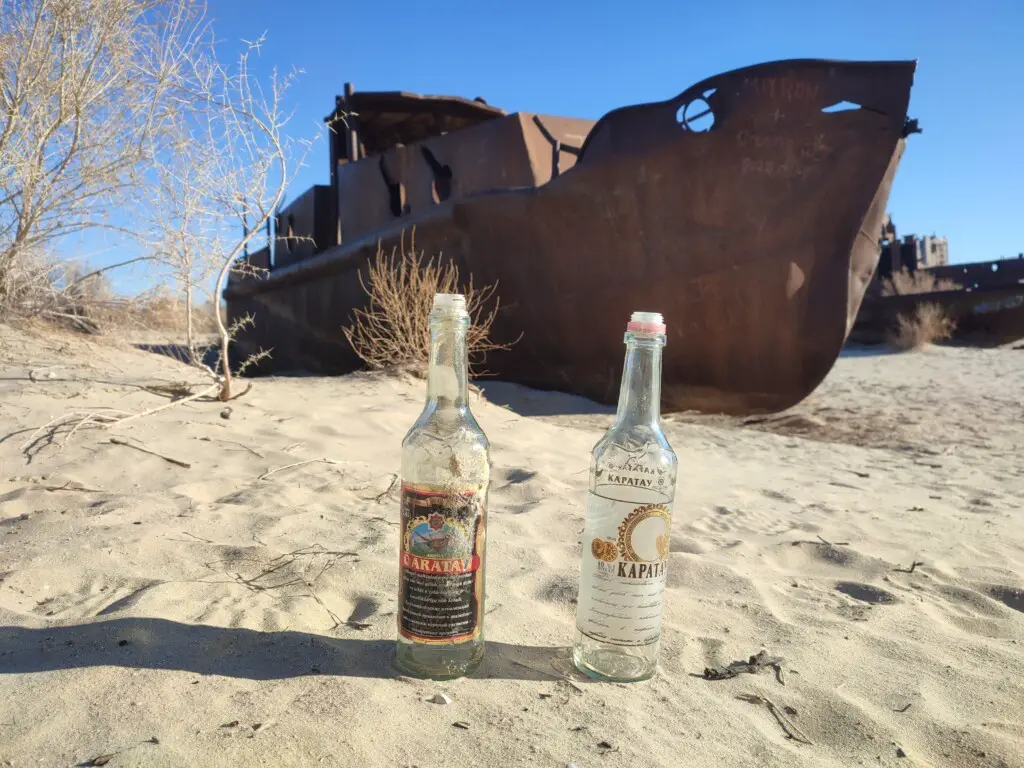
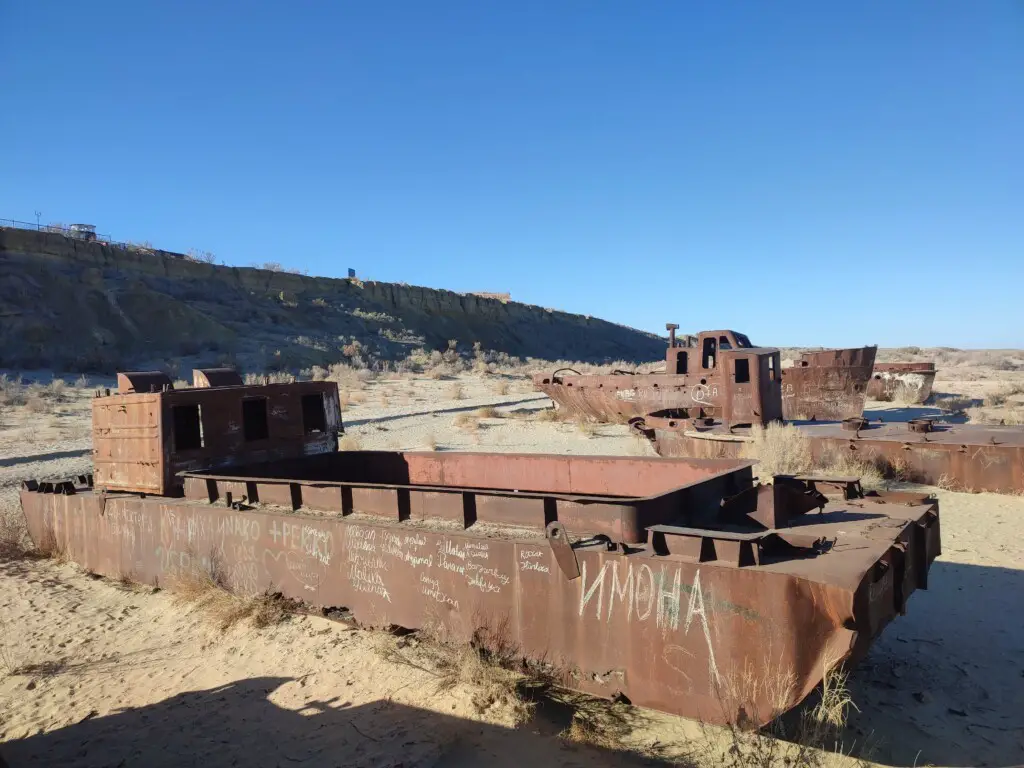
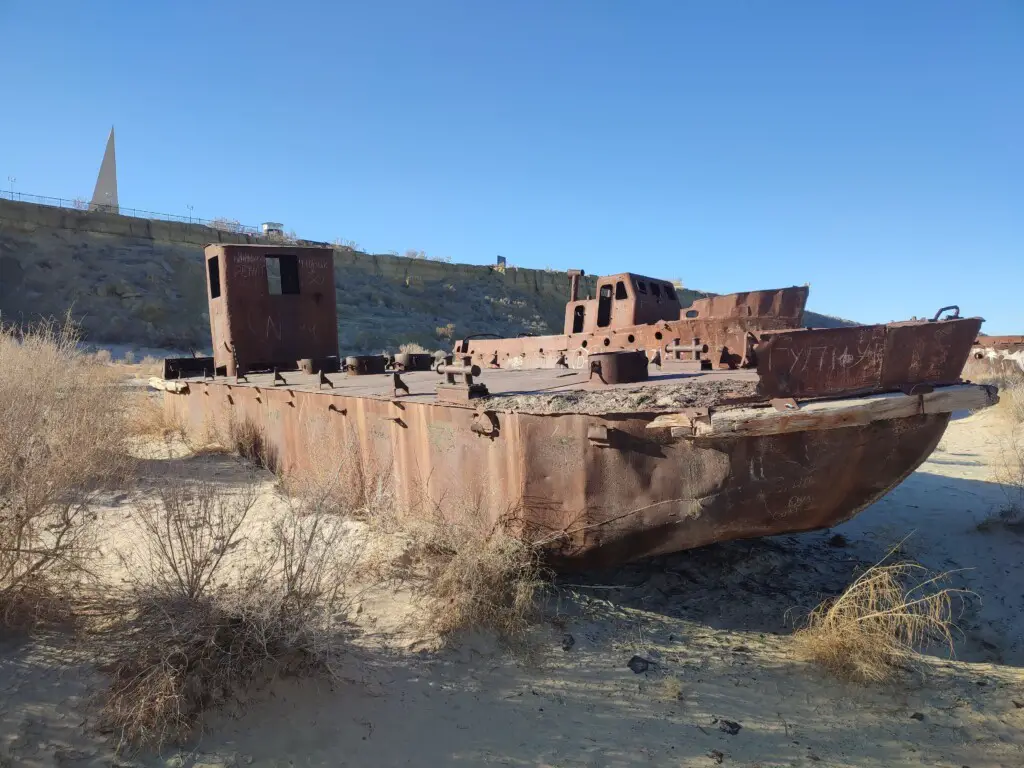
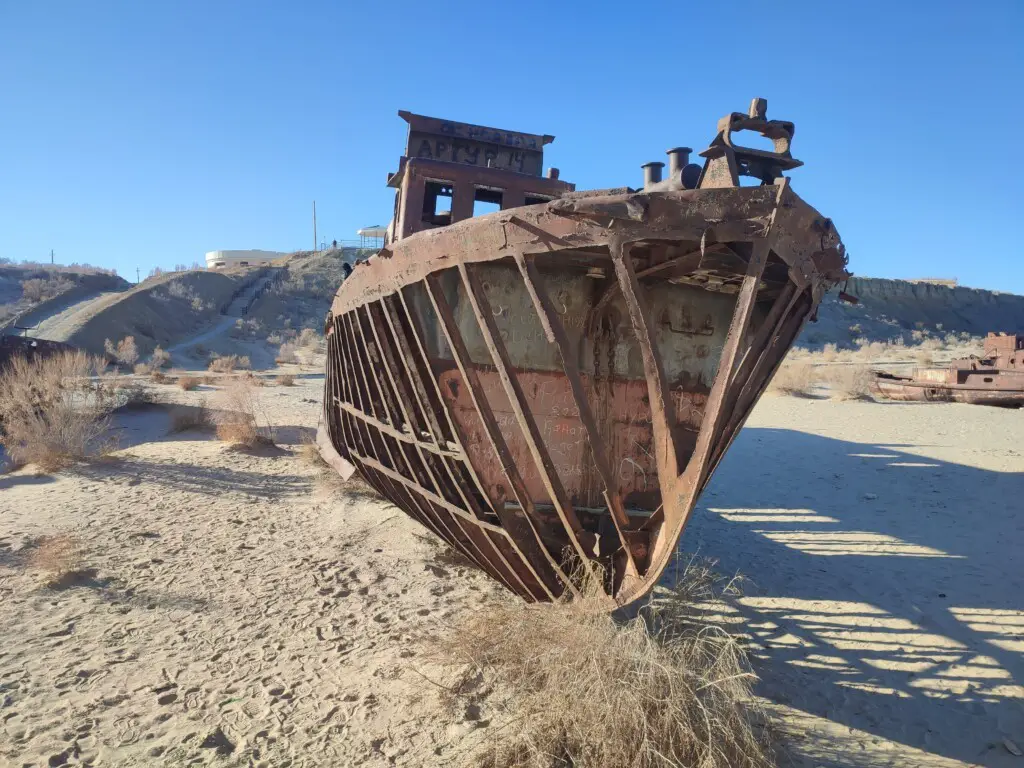
The Regional History and Aral Sea Museum
This is a small museum halfway between the bus station and the ship graveyard. I couldn’t even visit it – when I got there a policeman told me to come back later as the staff was on lunch break.
When I came back 2 hours later it was closed. It carries a 30000 UZS /2.6$ entrance fee otherwise.
Museum of the Aral Sea
Not to be mistaken for the previous one! The Museum of the Aral Sea is right next to the (former) coastline, on the cliff above the Ship Graveyard. The entrance fee is 30000 UZS / 2.6$.
There are a few exhibits from the old times (canned fish, photos, paintings, stuffed animals) and a short movie that explains what happened to the Aral Sea. Totally skippable, but also kind of okay, considering the average state of museums in Uzbekistan.
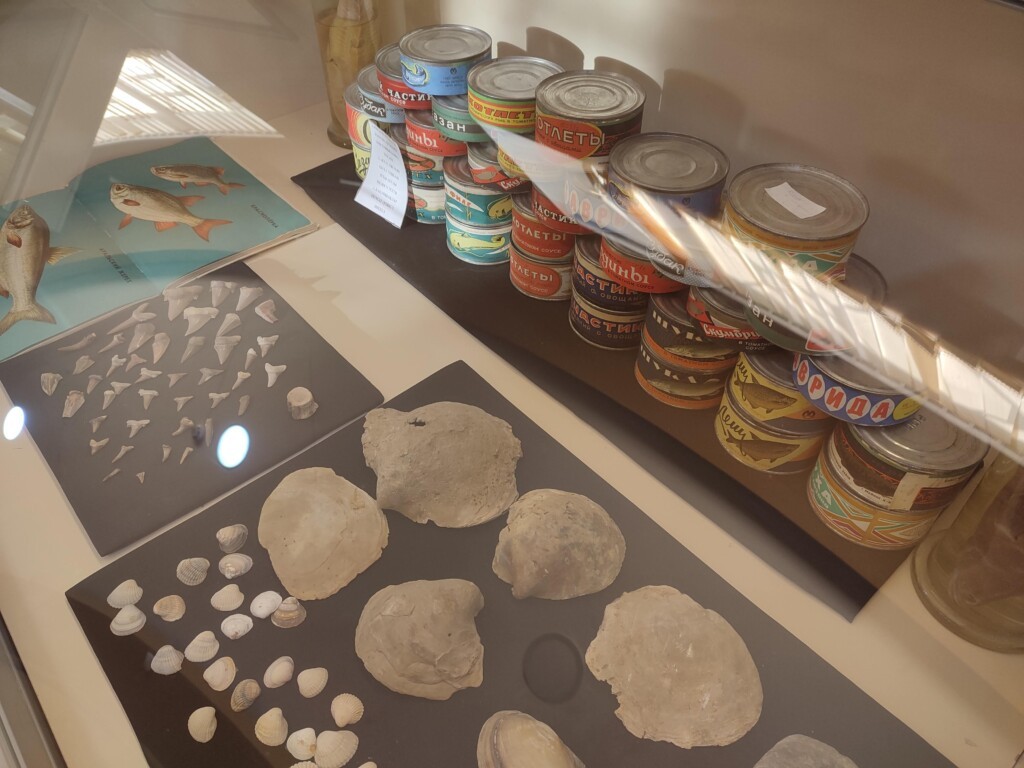
Aral Sea Monument
Right outside of the museum is a triangular monument commemorating mourning the death of the Aral Sea. It has pictures of how the sea shrank over the past 60 years and a few words about why it happened.
Stihia Festival
For the past couple of years, there has been light at the end of the tunnel for Muynaq and Karakalpakstan. On the cultural front, this comes from the Stihia Festival – an electronic music, arts, and science festival that takes part in late summer in Muynaq.
In 2022 it was so popular, that in 2023 the festival expanded its geographical boundaries to include more locations (although its development projects remain focused on Muynaq).
See its official website for more info and how to buy tickets.
Aral Sea Tours
You can arrange a private tour of the Aral Sea from Nukus. As far as I know, it’s quite hard to find a 4×4 in Muynaq that would take you around the sand and to the new coastline, so you must arrange that in Nukus.
They are expensive though. A two-day tour of the Aral Sea may cost up to 400$. If you’re really into exploration, do book this one, otherwise, I would skip it in favor of a self-organized trip to Muynaq.
The Jipek Joli Inn in Nukus also organizes tours. These will set you back 600$ for a jeep with tents and meals included.
You can book this 2-day Jeep adventure to the Aral Sea online too.
Where to stay in Muynaq
Hostels and Hotels
I stayed at Hostel Muynaq on the main street and in late November it appeared the be the only open accommodation available in the town. It was warm, tea on demand, wifi was good, price was 100000 UZS / 8.8$ and the host was very nice. I can totally recommend it.
Unfortunately, there’s no option to book online, so turn up and check-in.
If you want to have a booking and be safe and secure and all, then Hotel Ratmina is your option. It’s more expensive to book online though, keep that in mind.
Yurt Camp
There’s a yurt camp right next to the Ship Graveyard and the old lighthouse. The yurts are very basic and quite cheap, with a very unique location.
Nevertheless, I do not recommend them. In the summer they get incredibly hot and in the winter too cold (if the camp is open at all).
Other practical info about visiting Muynaq
Food
Contrary to what some online and offline guides say, there are a few convenience stores in Muynaq that sell everything you need during your stay.
There are also at least 3 restaurants, open year-round, so you won’t starve and there’s no need to carry food from Nukus or Kungrad.
Water
Do NOT drink the tap water. After years of pollution and the whole ecological collapse shebang, the water is not safe to drink. People in Muynaq are often sick.
Weather
Due to ecological problems, the temperature spread has increased by at least 20 degrees Celsius. That means summers are nowadays 10 or more degrees hotter and winters 10 or more degrees colder (on average).
I was in Muynaq in late November and it was so cold! The winter jacket, scarf, gloves, and hat didn’t help a lot in the face of the piercing cold wind. Dress appropriately.
How did the Aral Sea disaster happen?
As with many other catastrophes in the 20th century, the Aral Sea ecological disaster was caused by a combination of profit-seeking and gross negligence.
Let me elaborate with a bit of history.
Back in the 1960s, the Cold War was raging, the Space Race was heating up, and the people of the USSR had finally recovered from the death and destruction of the Second World War. There was one thing that the Soviets liked the most – productivity in agricultural production.
That’s why, in a bout of sheer madness, they decided to divert two timeless rivers (Amu Darya and Syr Darya) that flowed through the region and into the Aral Sea in order to irrigate a desert and grow cotton.
Cotton needs soooo much water! This plan was madness, but those were the realities of Communism – nothing is impossible, if the people will it (and work hard and recite Marx of course).
Well, this wasn’t impossible either and Uzbekistan did in fact become one of the largest producers of cotton in the world in the 1980s.
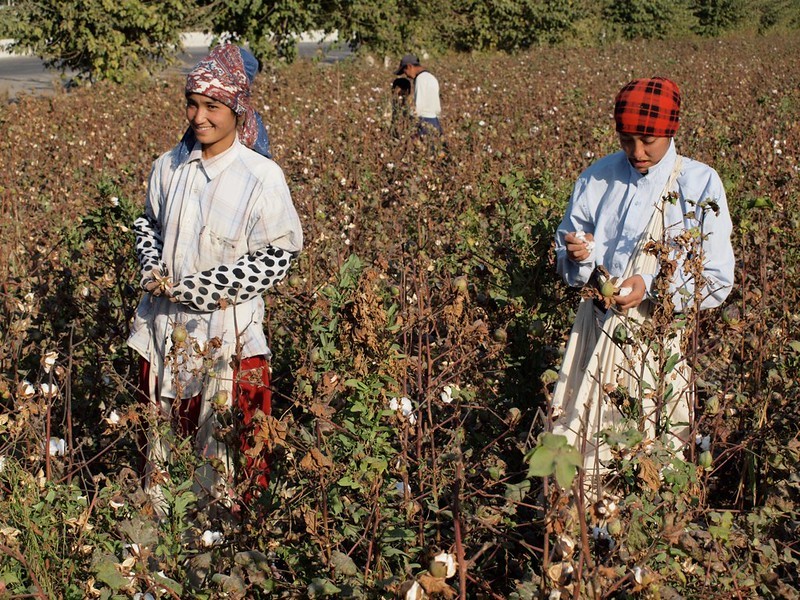
But the cost was great. The cost was humongous! Since many of the irrigation canals were poorly built, a lot of the water (as much as 80%) evaporated and was lost. Less and less water reached the Aral Sea, leading to a spike in salinity levels, killing all the wildlife there.
In the 1990s the Aral Sea was saltier than the Dead Sea.
Moreover, the fertilizers and pesticides used also started building up in the soil around the Aral Sea. With desertification came poisonous winds that picked up these chemicals and spread them all around.
Believe it or not, the Soviet authorities knew about the problems and hazards as early as the 1960s. Some played it down, some said it was inevitable anyway and some plainly didn’t care.
Fast forward to today and the affected region lies mostly in the autonomous region of Karakalpakstan in northwest Uzbekistan. Its autonomy and being on not-so-good terms with the central government in Uzbekistan have meant a painfully slow regeneration of the region.
With a strong independence movement, Karakalpakstan has received little investment, making it the poorest region in Uzbekistan. Poverty and unemployment are rampant, and health issues are widespread.
